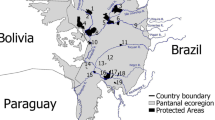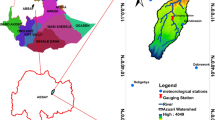Abstract
The object of this study was to answer a scientific question, i.e., how to determine the suitable scale of natural and artificial oases management based on water resource availability in an arid region. For this purpose, the Hotan River Basin was chosen as the study area, we analyzed the distribution characteristics of natural vegetation in the river basin using remote sensing images, water resources, weather, socioeconomic data, and field survey data. We also divided the natural vegetation into two ecological protection targets: the major and the basic protection zones. Suitable scales of oasis management were calculated under different inflow variations based on the above analysis. We had five major findings. (1) The total area of natural vegetation of the river basin is 4968.87 km2 with forestland, open forestland, high-covered grassland, and low-covered land accounting for 14.08, 14.98, 13.16, and 57.78 % of the total area, respectively. (2) In the middle reaches, the average vegetation distribution ranges for the west and east banks of the Yurunkax River are 5–8 and 34–51 km from the river, respectively. The average vegetation distribution ranges for the west and east banks of the Karakax River are 31–45 and 2–9 km from the river, respectively. In the lower reaches, the average vegetation distribution range is 3–10 km from the river. (3) During high-, normal-, and low-flow periods, the total available water for the river basin is 54.48 × 108, 42.67 × 108 and 34.00 × 108 m3, respectively. (4) The ecological water demand of the Hotan River is 8.85 × 108 m3, and the ecological water demands of the middle and lower reaches are 5.13 × 108 and 3.72 × 108 m3, respectively. (5) The optimal area for the natural oasis in the middle reaches is 3145–3293 km2. This study provides a theoretical basis for planning rational development of similar river basins in arid regions.





Similar content being viewed by others
References
Bandyopadhyay J (1987) Political ecology of drought and water scarcity. Econ Political Wkly 22(50):2159–2167
Chen YN (2010) Study on the eco-hydrology of Tarim River Basin in Xinjiang. Science Press, Beijing, pp 432–517
Cheng WM, Zhou CH, Liu HJ, Zhang Y, Jiang Y, Zhang YC, Yao YH (2006) The oasis expansion and eco-environment change over the last 50 years in Manas River Valley, Xinjiang. Sci China Ser D 49:163–175. doi:10.1007/s11430-004-5348-1
Congelton RG, Green K (1999) Assessing the accuracy of remotely sensed data: principals and practices. CRC Press, London, pp 137–145
Contreras S, Jobbagy EG, Villagra PE, Nosetto MD, Puigdefabregas J (2011) Remote sensing estimates of supplementary water consumption by arid ecosystems of central Argentina. J Hrdrol 397:10–22. doi:10.1016/j.jhydro1.2010.11.014
Eagleson PS (1982) Ecological optimality in water-limited natural soil-vegetation systems: 1. Theory and hypothesis. Water Resour Res 18(2):325–340. doi:10.1029/WR018i002p00325
Eagleson PS, Tellers TE (1982) Ecological optimality in eater-limited natural soil-vegetation systems: 2. Tests and applications. Water Resour Res 18(2):341–354
Fan ZL, Ma YJ, Zhang H, Wang RH, Zhao YJ, Zhou HF (2004) Research of eco-water table and rational depth of groundwater of Tarim River drainage basin. Arid Land Geogr 27(1):8–13 (in Chinese)
Fu JY, Xu HL, Zhao XF (2013) Differences in the impacts of flooding frequency and duration on riparian vegetation and soil in the Lower Tarim River. Acta Prataculturae Sin 22(6):11–20 (in Chinese)
Guan HT, Yang ZH, Song JP, Zhang LM (2005) Estimation of the requiring water quantity for maintaining the natural vegetation in Hetianhe river green corridor. J Water Resour Water Eng 16(1):71–74 (In Chinese)
Hu SJ, Song YD, Tian CY, Li YT, Li XC, Chen XB (2007) Suitable scale of Weigan River plain oasis. Sci China Ser D 50:56–64. doi:10.1007/s11430-007-8021-7
Huang LM, Shen B, Zhang GF (2008) Study on the suitable scale for Hotan oasis, Xinjiang. J Arid Land Resour Environ 22:1–4 (in Chinese)
Kovda VA (1987) Trend of biosphere change. Arid Zone Res 1:68–72
Lei ZD, Hu HP, Yang SX, Tian FQ (2006) Analysis on water consumption in oases of the Tarim Basin. J Hydraul Eng 37:1470–1475 (in Chinese)
Lei Y, Li XQ, Ling HB (2014) Model for calculating suitable scales of oases in a continental river basin located in an extremely arid region, China. Environ Earth Sci 73(2):571–580. doi:10.1007/s12665-014-3328-0
Li JL, Feng Q, Guo QL (2008) Fractal study of sustainable proportions of natural and artificial oases. Environ Geol 55:1389–1396. doi:10.1007/s00254-007-1089-8
Li WH, Li F, Chen ZS, Wang Y, Li BM (2011) Analysis of driving force of water consumption in plain and suitable scale of oasis in Hotan River Basin. J Glac Geocrvol 33:1161–1168 (in Chinese)
Ling HB, Xu HL, Shi W, Zhang QQ (2011a) Regional climate change and its effects on the runoff of Manas River, Xinjiang, China. Environ Earth Sci 64:2203–2213. doi:10.1007/s12665-011-1048-2
Ling HB, Xu HL, Zhang QQ, Shi W (2011b) Runoff variation law and its response to climate change in the headstream area of the Keriya River Basin. Xinjiang. J Earth Sci 22:780–791. doi:10.1007/s12583-011-0227-0
Ling HB, Xu HL, Fu JY (2013) High- and low-flow variations in annual runoff and their response to climate change in the headstreams of the Tarim River, Xinjiang, China. Hydrol Process 27:975–988. doi:10.1002/hyp.9274
Liu MT (1985) The vegetation investigation report of the middle and the lower reaches in the Hotan River. Arid Zone Res 4:8–14 (in Chinese)
Liu YX, Zhang XL, Lei J, Zhu L (2010) Urban expansion of oasis cities between 1990 and 2007 in Xinjiang, China. Int J Sust Dev World 17:253–262. doi:10.1080/13504501003764421
Lu DZ (1994) The vegetation along Hetian River bank and the ecological environment. J Beijing Agric Coll 9(2):153–160 (in Chinese)
Maneta MP, Tomes M, Wallender WW, Vosti S, Kirby M, Bassoi LH, Rodrigues LN (2009) Water demand and flows in the Sao Francisco River Basin (Brazil) with increased irrigation. Agr Water Manag 96:1191–1200. doi:10.1016/j.agwat.2009.03.008
Neilson RP (1995) A model for predicting continental-scale vegetation distribution and water balance. Ecol Appl 5:362–385
Richter BD, Mathews R, Harrison David L, Wigington R (2003) Ecologically sustainable water management: managing river flows for ecological integrity. Ecol Appl 13:206–224. doi:10.1890/1051-0761(2003)013[0206:ESWMMR]2.0.CO;2
Su YZ, Zhao WZ, Su PX, Zhang ZH, Wang T, Ram R (2007) Ecological effects of desertification control and decertified land reclamation in an oasis-desert ecotone in a region: a case study in Hexi Corridor, northwest China. Ecol Eng 29:117–124. doi:10.1016/j.ecoleng.2005.10.015
Tureniguli A, Li XG (2012) Land cover change detection in oasis of Hotan River Basin in Northwestern China. Future Control and Automation 172:45–51
Wang RH, Song YD, Fan ZL, Ma YJ (2001) Estimation on ecological water demand amount in four sources and one main stream area of Tarim Basin. J Soil Water Conserv 15(1):19–22 (in Chinese)
Wang GY, Shen YP, Zhang JG, Wang SD, Mao WY (2010) The effects of human activities on oasis climate change and hydrologic environment in the Aksu River Basin, Xinjiang, China. Environ Earth Sci 59:1759–1769. doi:10.1007/s11269-007-9218-4
Wang YB, Feng Q, Si JH, Su YH, Chang ZQ, Xi HY (2011) The changes of vegetation cover in Ejina oasis based on water resources redistribution in Heihe River. Environ Earth Sci 64(7):1965–1973. doi:10.1007/s12665-011-1013-0
Xu YP (1993) A study of comprehensive evaluation of the water resource carrying capacity in the arid area: a case study in the Hetian river basin of Xinjiang. J Nat Resour 8(3):229–237 (in Chinese)
Xu HL, Ye M, Li JM (2007) The influence of the river flooding disturbance on the native vegetation restoration in the lower reaches of Tarim River. Acta Ecol Sin 27(12):4990–4998 (in Chinese)
Xu CC, Chen YN, Yang YH, Hao XM, Shen YP (2010) Hydrology and water resources variation and its response to regional climate change in Xinjiang. J Geogr Sci 20(4):599–612. doi:10.1007/s11442-010-0599-6
Yang X, Liu Z, Mang F, White PD, Wang X (2006) Hydrological changes and land degradation in the southern and eastern Tarim Basin, Xinjiang, China. Land Degrad Dev 17:381–392. doi:10.1002/ldr.744
Ye CX, Chen YN, Li WH (2007) Ecological water demand of vegetation based on eco-hydrological processes in the lower reaches of Tarim River. Acta Geogr Sin 62(5):451–461 (in Chinese)
Ye Z, Chen Y, Li W (2014) Ecological water rights and water-resource exploitation in the three headwaters of the Tarim River. Quatern Int 336(12):20–25. doi:10.1016/j.quaint.2013.09.029
Zhao RF, Chen YN, Shi PJ, Zhang LH, Pan JH, Zhao HL (2013) Land use and land cover change and driving mechanism in the arid inland river basin: a case study of Tarim River, Xinjiang, China. Environ Earth Sci 68(2):591–604. doi:10.1007/s12665-012-1763-3
Acknowledgments
This work was supported by the West Light Foundation of The Chinese Academy of Sciences (XBBS-2014-13), the Main Service Project of Characteristic Institute of Chinese Academy of Sciences (TSS-2015-014-FW-2-2), and the National Natural Science Foundation of China (41471099, 41171427, 31370551, and 31400466).
Author information
Authors and Affiliations
Corresponding author
Additional information
This article is part of a Topical Collection in Environmental Earth Sciences on “Water in Central Asia,” guest edited by Daniel Karthe, Iskandar Abdullaev, Bazartseren Boldgiv, Dietrich Borchardt, Sergey Chalov, Jerker Jarsjö, Lanhai Li, and Jeff Nittrouer.
Rights and permissions
About this article
Cite this article
Guo, H., Ling, H., Xu, H. et al. Study of suitable oasis scales based on water resource availability in an arid region of China: a case study of Hotan River Basin. Environ Earth Sci 75, 984 (2016). https://doi.org/10.1007/s12665-016-5772-5
Received:
Accepted:
Published:
DOI: https://doi.org/10.1007/s12665-016-5772-5




